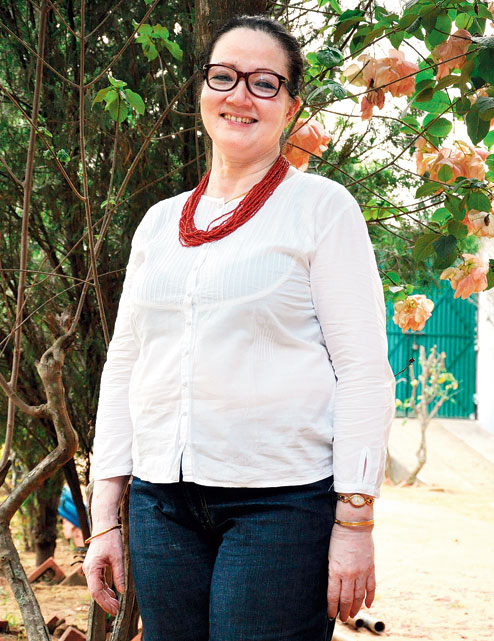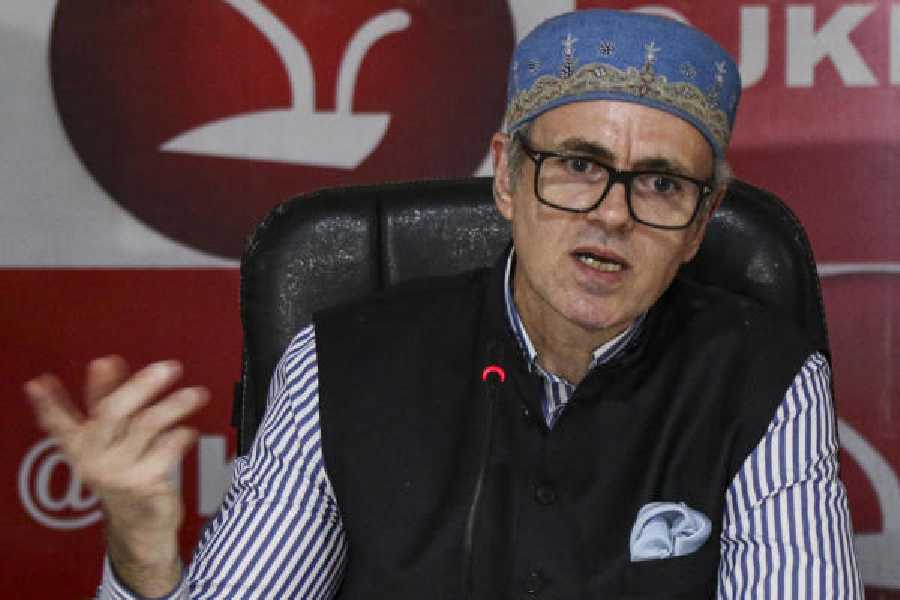Shabnam Ramaswamy. The force behind Jagriti, a sprawling English-medium public school for the poor in Katna village of Murshidabad, that is transforming the lives of hundreds of children.
Shabnam Ramaswamy. The force behind Stree Shakti, a cooperative of, for and by the women in Katna village of Murshidabad, that is touching the lives of hundreds of women.
Shabnam Ramaswamy. The La Martiniere girl treated in her village as a fairy who had promised herself she would someday build such a school there for girls.
Shabnam Ramaswamy. The battered housewife thrown out of the house one night and forced to start life again from Sealdah railway platform.
Shabnam Ramaswamy. The 60-year-old grandmother who grabbed life by the collar and made it do her bidding.
Metro brings you her story.
Tale of two worlds
I was born Shabnam Ahmed in this village (Katna, in south-west Murshidabad). My father became a doctor. It changed our family’s world because the previous generations were ordinary farmers. My grandmother was keen that I learn English so I was put into Loreto Asansol when I was five. My father joined the army and I kept moving with him to Bangalore, Delhi, going through many schools before settling down in La Martiniere in Calcutta when I was nine. I lived in the hostel and finished school there.
During holidays, I would visit this village where my grandmother still lived. I was a child of the ’60s so through my teenage years, I was being challenged to see this huge difference between the girls in Katna and me. Here I was in my fancy dresses, my shampooed hair, my music, literature and worldviews. It was the time of The Beatles, the Vietnam War and the bra burning movement.
Back in the village, I’d often wonder how I turned out to be the chosen one that people would treat like a fairy. As I grew up I sensed how much of these differences, the social and religious divisions, were actually man-made. Coming into my teenage years I would tell myself, if I ever have money I’m going to come back to this village and build a school, like the school I go to.
I was married off very young, just after school. I did resist but it didn’t help. He was 34 while I was all of 16.
Beaten & abandoned
It was an arranged marriage. My husband was an architect and into the leather business but with the conditioning of an extremely orthodox household. I went from being the sporty girl in shorts doing high jumps and javelin throws to being pushed 100 years back. I wasn’t allowed to go out, had no control over my body. I got pregnant six times but only two of my children survived. He was a womaniser and would often come home and beat me to a pulp. I had to undergo abortion at seven months once and I also gave birth to a stillborn. There was excessive physical abuse. It felt like I was being choked at every step.
16metquote |
| Shabnam Ramaswamy at Jagriti’s hostel campus in Katna. Pictures by Anup Bhattacharya |
 |
| Jagriti Public School, the sprawling four-storeyed English-medium school that Shabnam set up in her ancestral village Katna in Murshidabad |
 |
| Shabnam shows off kantha handiwork by the women of Stree Shakti |
 |
I carried on for eight years until one evening when he bashed me up and threw me out of the house with my three-year-old son. He kept my baby daughter who I was still breast-feeding. That night I decided that I was not going to go back, bang on his door and beg for mercy. The streets could not be worse than this. That’s the gamble I took. I was 24 then.
I went to the Sealdah railway station to stay the night and headed to one of our servants’ house the next morning, pleading with her to keep me hidden for a few days. Then I sold my gold chain and bangles and took a train to Pune where my father was.
But he felt I’d be a bad influence on my siblings and their lives. So I cut myself off from them and returned to Calcutta, ready to start life from the streets. I lived on Sealdah railway platform for two months, all the while telling myself, ‘Woh subah kabhi toh meri hogi’.
Platform to office
Living on the platform, under tarpaulin sheets, sometimes inside a railway bogey and surviving on muri and mangoes, I needed to find a home and then a job. I also had to begin my legal fight for divorce and to get my daughter back.
I found these lodges in Bowbazar, with rooms at Rs 50 a day, which I rented. I’d leave my son with the door locked from outside and go job-hunting. Knowing English helped and I got a front-desk job at Marie Stopes Clinic on Free School Street for Rs 1,200.
I then enrolled myself in the evening classes at Viharilal College for home science. I also needed to acquire a skill that would pay. Since I had a passion for painting, designing and decorating, I learnt technical drawing and drafting in the evenings for a year before I was ready to start my own company. I called it Visual Interiors.
I shifted out of Bowbazar to Kidderpore. A friend gave me table space in her office in Dalhousie. Because my husband was an architect, I knew a lot of karigars who I connected with. I got some cards printed, promised to bring clients and give them an equal share in profits. Starting out with an assignment that fetched us Rs 75,000, there was no looking back.
Dilli Chalo
Over the next few years, step by step, I managed to rebuild my life. I managed to get my divorce and bring my daughter back. I put my children in school, bought a car and also a flat in Salt Lake. I was getting back what life had snatched away from me. I had my chiffons and my diamonds… I became quite a socialite!
But at one point of time I decided that I had to close the door on my past and make a fresh start. It was time for another gamble.
I scribbled the names of six cities, got my daughter to pick a chit. She picked Delhi. So we packed our bags and left in search of a new and meaningful identity.
We settled down in west Delhi and I began with a desire to create opportunities for street children. I stumbled upon an ad about the Salaam Balak Trust that Mira Nair had set up after the success of Salaam Bombay. They were starting a project on street children at New Delhi railway station and looking for a project co-ordinator. I went for the interview with Barry John, Manoj Bajpai and Ashish Vidyarthi on the panel. Once more, a degree was an issue because they needed someone with a master’s in social work. But I convinced them that a heart in the right place is what you need and not a degree.
I was given a space on the terrace of the railway police station. That’s when I met my second husband Jugnu Ramaswamy, a journalist, who was making a documentary for Unicef. Over a period of one year we grew close. For the sake of my children, going through the symbolic act of marriage was important. So we married and together with my children went on our honeymoon. Life just changed after 1990.
Jugnu and I established our own NGO called Street Survivors of India (SSI) and started work in a Delhi slum. We worked for eight years until the slum was demolished in a clean-up drive for commercial space. The SSI building was razed to the ground.
Ironically, this paved the way for my teenage dream of building a school someday in my village Katna.
The homecoming
Jugnu sold off his house in Delhi and with all our savings we came to Bengal in 2000 to fulfil our dream. We bought a plot of land in the middle of nowhere. It was a Muslim belt with severe poverty and deprivation, very conservative and educationally backward.
One evening, when we were getting two floors built to start the school, bombs were hurled at us. Our car went up in flames and we later found out that four men had been paid to kill us. We were a challenge to the set hierarchy in that area and for two years it was a struggle to survive. Fourteen days before the inauguration of our Jagriti Public School, Jugnu passed away following a cardiac arrest.
I didn’t know how I was going to do it all by myself. After the inauguration, local maulvis came to me complaining about my influence on the women and children in the village. I made it clear that I was not going to change. I was there to teach children and help them overcome difficulties.
I’d go from village to village in a car with a mike and a folding chair asking people to invest Rs 10 in their children’s education. I made sure it was an English-medium school in order to create real opportunities for these children. We started with around 40 kids, a two-storey building, a few local teachers and no infrastructure beyond that.
That’s when I thought of using people’s skills and making that marketable. Murshidabad has its unique graphic kantha style. It was a craft that was languishing. So I started a kantha project with 12 of the mothers.
As these women found monetary strength and confidence in this occupation, more women stepped out of their homes and joined in. The money from the sale of kanthas helped fund the school.
As more women came together, they also started to discuss the problems they were facing at home, of being harassed by their husbands and in-laws. This in turn led me to form Stree Shakti, a forum that began with 12 women. They could come and express themselves without being intimidated and we would listen to their problems, counsel and try to solve their disputes.
I also had my brush with politics when I stood for the panchayat elections in 2008 and won. I loved the thought of being able to take action at that level. But the scale of corruption was so huge that it was disillusioning. A year later, I resigned.
Today, Jagriti Public School is a full-fledged CBSE school with 643 boys and girls. Here children read, write and speak in English and nurse ambitions of being a doctor, lawyer or engineer while students from Australia, Princeton and New York universities come to intern.
And Stree Shakti is a full-fledged company of 1,432 women with an annual turnover of more than a crore. It has helped the women in Katna to be self-sufficient, travelling around in cycles and scooties. The older women train the younger ones and the kantha products they create have travelled the world, from Hauz Khas Village in Delhi to Byloom in Calcutta, from Iran to Milan.
--------------------O--------------------
As we sit and chat inside Shabnam’s room on the hostel campus of Jagriti, there is no escaping a tall man who serves us tea, chauffeurs her around and acts as her bodyguard and Man Friday.
“He is one of the four men who was once hired to kill me. After being on the run for days, he arrived at our doorstep one night begging for mercy. He now takes care of us. His daughter goes to our school and their lives have changed,” smiles Shabnam.
Shabnam’s daughter works towards ending violence on women and children with an NGO in Delhi and her son is a professional photographer.
The spunky 60-year-old grandmom of two loves her jeans, loves her beer and loves to party when she visits her little flat in Delhi.
“City life doesn’t attract me anymore,” says Shabnam, looking forward to her first visit to the US where she has been invited to speak at Aspen University.
Her day begins at four every morning, when she sits with her tea, faces the sun to “stare at it head-on” before going about her day’s work. During alone times, she loves to read everything from Roald Dahl to Raymond Chandler. Her wardrobe is a little treasure trove of colourful bangles, scarves and neckpieces that mirror her brighter self.
“When you’re young, you anyway look good. It’s when you’re old that you need to dress up and look good. I totally believe that when you’re 60, poorey dum se jiyo!” smiles Shabnam.
With a pause, she adds: “See, I held life by its collar, pushed it to the wall and said ‘you live according to me and not me according to you!’ Toh poora dum se jeetey hain.”
What is your message for Shabnam? Tell ttmetro@abpmail.com










